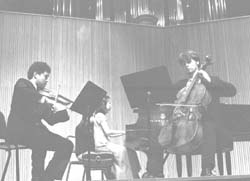|
News
|
|
|
Perspectives
|
|
|
Arts
|
|
|
Sports
|
|
|
Other
|
|

Student Composers Present Reflective New Work
Musicians Test Original Work Before Warner
by Colin Booy

|
|
Meditative Mood: Sophomore Yang Xu (left), grad. student Yuan Tian and Christopher Leroux charmed the audiance at their Artist Diploma recital Wednesday.
(photo by Lea Morgenstern)
|
A small and appreciative audience graced Warner Hall Tuesday in what was to be a surprisingly reflective, even pensive, program of new student compositions. The evening began with senior Nicholas DeMaison's Tears of Blood, a choral setting of the Kyrie and Agnus Dei portions of the Catholic Mass. Scored in the traditional four-part format, the piece employed the slow melodic movement and modal harmonies familiar to the ancient form.
Yet there was a more recent influence at work: that of the so-called neo-classical mystical minimalists, particularly the work of Estonian composer Arvo Part. While DeMaison's score captured much of the solitary eloquence of Part's music, it lacked the passionate eruptions which characterize his better offerings; the relative brevity of DeMaison's arrangement prevented the listener from being drawn into the existential space which the Mass can create. The singing was generally good, although at points the sylistic clash between parts (junior C. Louise McGauley's operatic soprano, DeMaison's dry tenor) obscured the harmonies. Neoclassicism at its best refracts the present through past convention, shedding light on both referents. Tears of Blood, while beautiful, seemed ultimately derivative - creating a distant, impersonal beauty.
Senior Marcus Lofthouse's Nocturne No. 2 for solo piano was second on the program. The piece opened with the ascending low-register arpeggios common to any number of Romantic nocturnes and generally adhered to this harmonic strategy throughout, employing slightly atonal variations and ambiguous modulation to loosen the classical structure. The Nocturne invoked a pleasing sense of emotional ambiguity, but finally reached a stasis born of its meandering lines. Junior pianist Emily Manzo's playing was graceful and elegant.
The concert took on a more ominous note with the opening of junior Grisha Krichevnia's Cello Quartet. Played by cellists junior Jonathan Dexter, junior Adam Friedberg, first-year Laura Belous and sophomore Anna Steinhoff, the piece began with a low bowed note which gradually expanded into a dense, pulsating tone cluster reminiscent of Ligetti's Lux Aeternum (familiar from the moonwalk-monolith sequence from Kubrick's 2001: A Space Odyssey). This darkly beautiful feel was not sustained, however, in the wandering cello lines which followed it, resulting in a falling-off from the hair-raising intensity of the quartet's beginning.
The last work of the evening, junior Stefan Tcherepnin's string quartet 1 x 4 = 1, proved to be its highlight as well. The piece unfolded as a series of distinct but related units, marked out from each other by extended pauses. The breath-like units generally began with a single entrance, often the violin, and expanded with the polyrhythmic, almost canonic introduction of the other players. Together they formed a richly textured interweaving of voices which was entrancing and intricate, alternating legato bowing with pitzicatto and col legno segments. The sections seemed to waft over the listener, as if pulsating bubbles were gently floating from the stage.
That Tcherepnin's score (and conductor Lewis Nielson's hand) could hold it all together was a small miracle. The musicians ( senior Erica Dicker and sophomore Gillian Rivers, violins; junior Amy Cimini, viola; senior Roberta Reynolds) displayed commendable finesse and musicality.
Writing on his composition, Tcherepnin stated, "One way of understanding [the title] is that 'four stringed instruments = string quartet = one sound, one instrument.'" And indeed, 1 x 4 = 1 does speak as one voice, breaking down any traditional dichotomy between harmony and melody. What emerged in its stead was an organic fusion of form to content, and a listening experience that contained multitudes.
Copyright © 2000, The Oberlin Review.
Volume 129, Number 8, November 10, 2000
Contact us with your comments and suggestions.